Evaluating and Diagnosing Urban Function and Perceived Quality Based on Multi-Source Data and Deep Learning Using Dalian as an Example
Abstract
1. Introduction
2. Literature Review
2.1. Study of Urban Function and Perceived Quality
2.2. Methods of Measuring Urban Function and Perceived Quality
3. Materials and Methods
3.1. Research Framework
3.2. Study Site
3.3. Evaluation and Analysis Methods
3.3.1. Data Collection
3.3.2. The Establishment of the Evaluation System
3.4. Spatial Diagnosis
4. Results
4.1. Analysis of Street Accessibility
4.2. The Analysis of Urban Functions
4.3. The Analysis of Perceived Quality
4.4. Spatial Diagnostics
4.4.1. The Spatial Diagnosis in Terms of High-Accessibility Streets
4.4.2. The Spatial Diagnosis in Terms of Low-Accessibility Streets
5. Discussion
5.1. The Analysis of the Coupling Between Street Accessibility and Urban Functions
5.2. Identify the Priority Roads in the Location
5.3. Limitations
6. Conclusions
- (1)
- In the core area of Dalian, high-accessibility streets were mainly located in the central region, while low-accessibility streets mainly located in the urban periphery;
- (2)
- High-accessibility streets have a higher perceived quality than low-accessibility streets. Specifically, in terms of psychological perceptions, lively, safe, and depressing perceptions scored higher in regard to high-accessibility streets than low-accessibility streets. In terms of objective perceptions, high-accessibility streets ranked lower than low-accessibility streets. Greenness, the amount of paved sidewalks, and walkability in high-accessibility streets need to be improved;
- (3)
- By comparing the density of urban amenities, shopping services were ranked the highest in regard to high-accessibility streets and low-accessibility streets. However, public services were ranked the lowest;
- (4)
- Through carrying out coupling analysis, this study found that high-accessibility streets and low-accessibility streets share similar advantages and problems in regard to the four street types. The proportion of advantage streets and opportunity streets were high in regard to the four types of streets. The density and diversity of urban amenities were the highest in regard to advantage streets. In terms of psychological perceptions, depressing, lively, safe, and wealthy were ranked the highest in regard to the four street types. In terms of objective perceptions, paved sidewalks and imageability were ranked the highest in terms of the four types of streets. In regard to the maintenance streets, beautiful was ranked the lowest of the four street types. In regard to the improvement streets, the objective perception was ranked the highest in terms of the four types of streets. However, beautiful was ranked the highest. In regard to opportunity streets, openness was the highest ranked of the four types of streets.
Author Contributions
Funding
Data Availability Statement
Acknowledgments
Conflicts of Interest
Appendix A
Appendix A.1
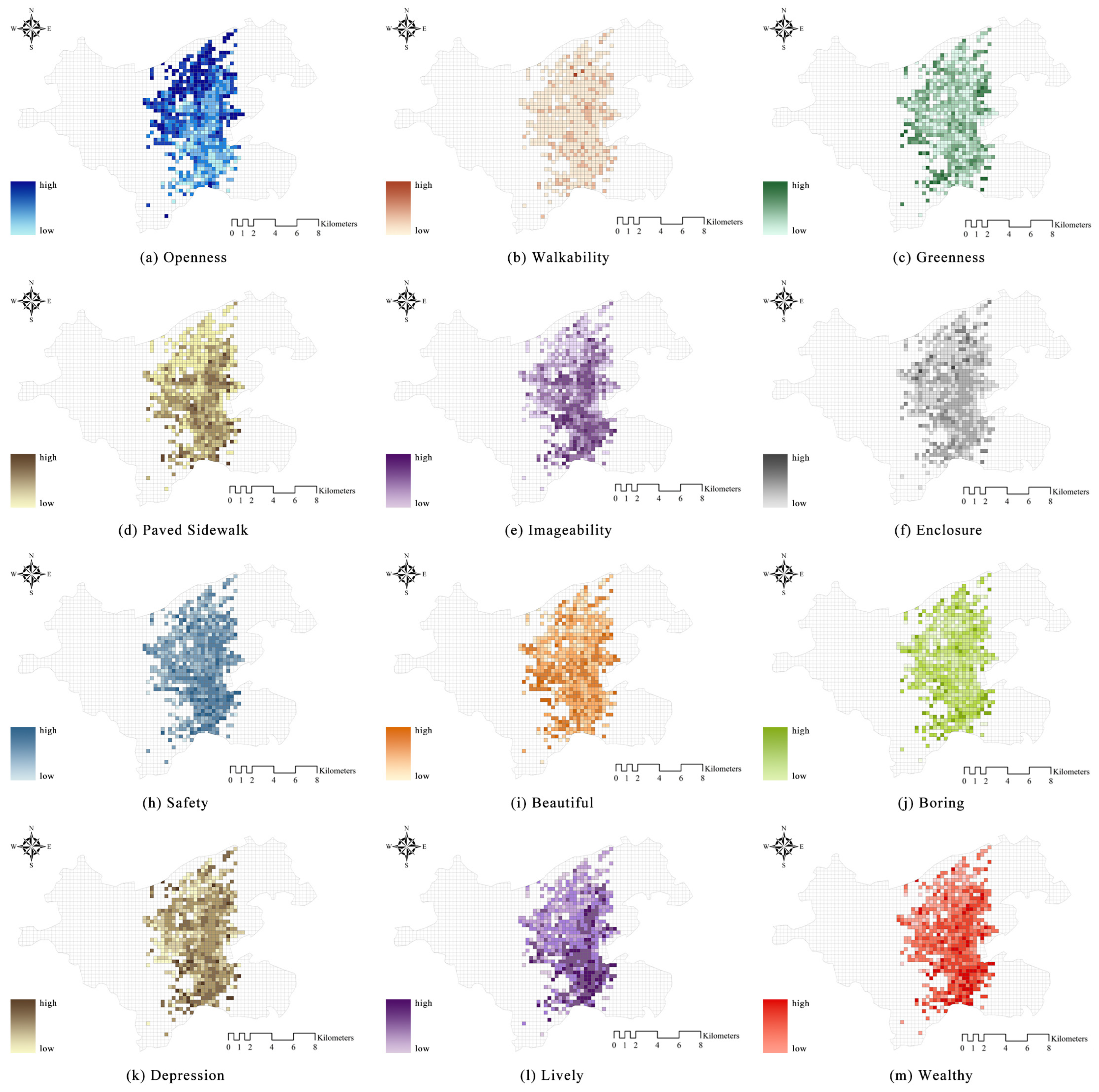
Appendix A.2
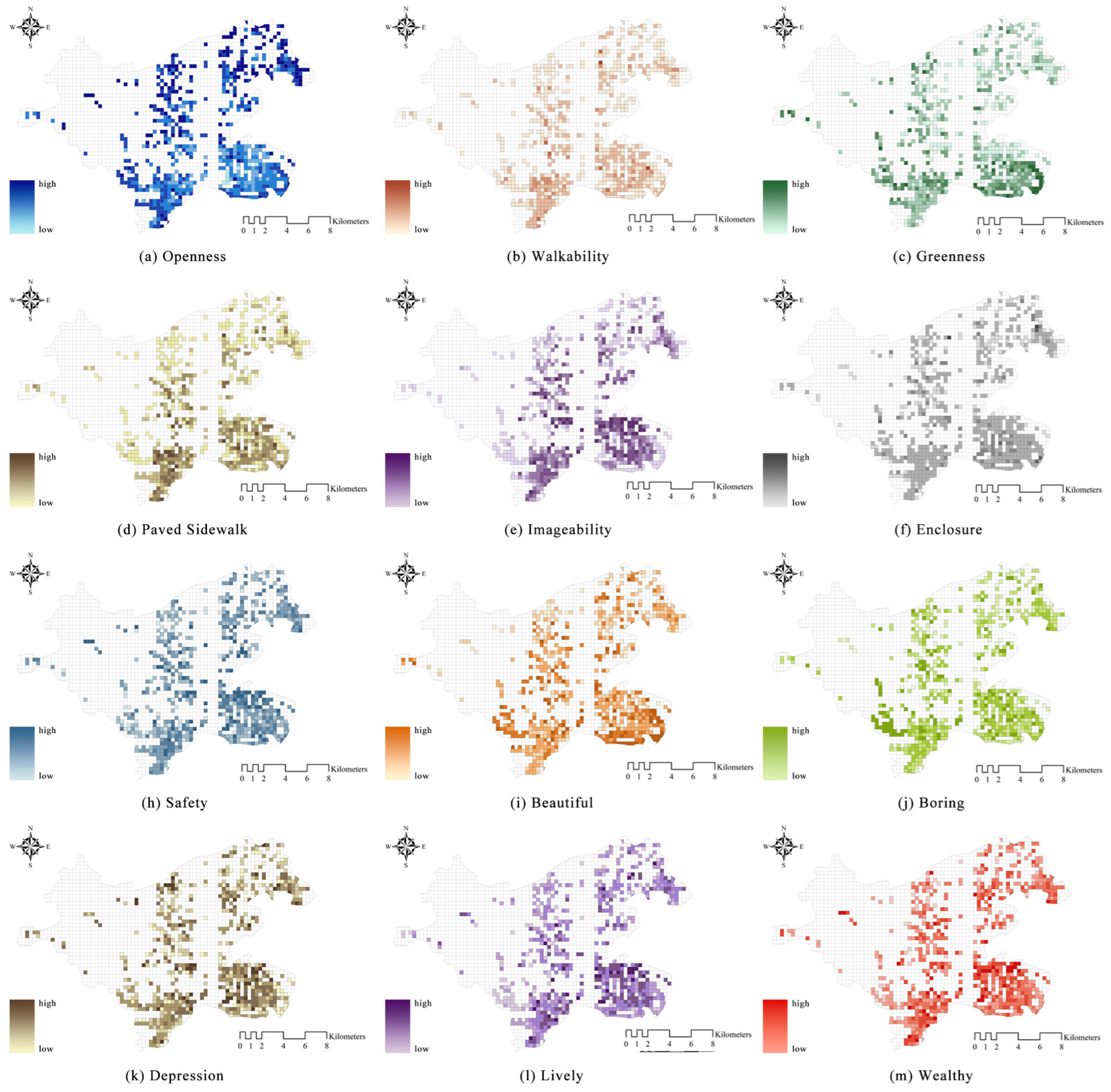
References
- Gehl, J. Cities for People; Island Press: Washington, DC, USA, 2010. [Google Scholar]
- Cai, Z.; Kwak, Y.; Cvetkovic, V.; Deal, B.; Mörtberg, U. Urban spatial dynamic modeling based on urban amenity data to inform smart city planning. Anthropocene 2023, 42, 100387. [Google Scholar] [CrossRef]
- Smith, B.A. Measuring the value of urban amenities. J. Urban Econ. 1978, 5, 370–387. [Google Scholar] [CrossRef]
- Larsson, A.; Elldér, E.; Vafeiadis, E.; Curtis, C.; Steiner, A. Exploring the potential for sustainable accessibility across settlement types. A Swedish case. Transp. Res. Part D: Transp. Environ. 2022, 107, 103297. [Google Scholar] [CrossRef]
- Olsen, J.R.; Thornton, L.; Tregonning, G.; Mitchell, R. Nationwide equity assessment of the 20-min neighbourhood in the scottish context: A socio-spatial proximity analysis of residential locations. Soc. Sci. Med. 2022, 315, 115502. [Google Scholar] [CrossRef] [PubMed]
- Olsen, J.R.; Nicholls, N.; Whitley, E.; Mitchell, R. Association between local amenities, travel behaviours and urban planning: A spatial analysis of a nationwide UK household panel study. J. Transp. Health 2024, 36, 101784. [Google Scholar] [CrossRef]
- Xiao, Y.; Wang, Z.; Li, Z.; Tang, Z. An assessment of urban park access in Shanghai—Implications for the social equity in urban China. Landsc. Urban Plan. 2017, 157, 383–393. [Google Scholar] [CrossRef]
- Jane, J. The Death and Life of Great American Cities; Random House: New York, NY, USA, 1961. [Google Scholar]
- Carmona, M. Public Places Urban Spaces: The Dimensions of Urban Design, 3rd ed.; Routledge: London, UK, 2021. [Google Scholar]
- Zhang, G.; Xing, L. Research on tourism economic effect under the threshold of new-type urbanization in coastal cities of China: From the perspective of development economics. Ocean. Coast. Manag. 2023, 239, 106587. [Google Scholar] [CrossRef]
- Özer, M.; Küçüksakarya, S.; Maiti, M. Nexus of tourism demand, economic growth, and external competitiveness in leading tourist destination countries. Tour. Manag. Perspect. 2022, 42, 100965. [Google Scholar] [CrossRef]
- Santamaria, D.; Filis, G. Tourism demand and economic growth in Spain: New insights based on the yield curve. Tour. Manag. 2019, 75, 447–459. [Google Scholar] [CrossRef]
- Montgomery, J. Making a city: Urbanity, vitality and urban design. J. Urban Des. 2007, 3, 93–116. [Google Scholar] [CrossRef]
- Gehl, J. Life Between Buildings: Using Public Space; Island Press: Washington, DC, USA, 2011. [Google Scholar]
- Liu, J.; Meng, B.; Shi, C. A multi-activity view of intra-urban travel networks: A case study of Beijing. Cities 2023, 143, 104634. [Google Scholar] [CrossRef]
- Burger, M.J.; van der Knaap, B.; Wall, R.S. Polycentricity and the Multiplexity of Urban Networks. Eur. Plan. Stud. 2013, 22, 816–840. [Google Scholar] [CrossRef]
- Yang, X.; Zheng, X.; Cao, Y.; Chen, H.; Tang, L.; Yang, H. Connectivity analysis in pedestrian networks: A case study in Wuhan, China. Appl. Geogr. 2023, 151, 102843. [Google Scholar] [CrossRef]
- Li, H.; Wei, Y.D.; Wu, Y. Urban amenity, human capital and employment distribution in Shanghai. Habitat Int. 2019, 91, 102025. [Google Scholar] [CrossRef]
- Glaeser, E.L.; Kominers, S.D.; Luca, M.; Naik, N. Big Data and Big Cities: The Promises and Limitations of Improved Measures of Urban Life. Econ. Inq. 2016, 56, 114–137. [Google Scholar] [CrossRef]
- Mulligan, G.F.; Carruthers, J.I. Amenities, Quality of Life, and Regional Development. In Investigating Quality of Urban Life; Marans, R., Stimson, R., Eds.; Springer: Dordrecht, The Netherlands, 2011. [Google Scholar]
- Mobley, L.R.; Root, E.D.; Finkelstein, E.A.; Khavjou, O.; Farris, R.P.; Will, J.C. Environment, obesity, and cardiovascular disease risk in low-income women. Am. J. Prev. Med. 2006, 30, 327–332. [Google Scholar] [CrossRef] [PubMed]
- Kaczynski, A.T.; Besenyi, G.M.; Stanis, S.A.; Koohsari, M.J.; Oestman, K.B.; Bergstrom, R.; Potwarka, L.R.; Reis, R.S. Are park proximity and park features related to park use and park-based physical activity among adults? Variations by multiple socio-demographic characteristics. Int. J. Behav. Nutr. Phys. Act. 2014, 11, 146. [Google Scholar] [CrossRef]
- Halonen, J.I.; Stenholm, S.; Kivimaki, M.; Pentti, J.; Subramanian, S.V.; Kawachi, I.; Vahtera, J. Is change in availability of sports facilities associated with change in physical activity? A prospective cohort study. Prev. Med. 2015, 73, 10–14. [Google Scholar] [CrossRef]
- Sarkar, C.; Webster, C. Urban environments and human health: Current trends and future directions. Curr. Opin. Environ. Sustain. 2017, 25, 33–44. [Google Scholar] [CrossRef]
- Ewing, R.; Cervero, R. Travel and the Built Environment. J. Am. Plan. Assoc. 2010, 76, 265–294. [Google Scholar] [CrossRef]
- Tahmasbi, B.; Mansourianfar, M.H.; Haghshenas, H.; Kim, I. Multimodal accessibility-based equity assessment of urban public facilities distribution. Sustain. Cities Soc. 2019, 49, 101633. [Google Scholar] [CrossRef]
- Ashik, F.R.; Mim, S.A.; Neema, M.N. Towards vertical spatial equity of urban facilities: An integration of spatial and aspatial accessibility. J. Urban Manag. 2020, 9, 77–92. [Google Scholar] [CrossRef]
- Xu, Y.; Zhang, Q.; Zheng, S. The rising demand for subway after private driving restriction: Evidence from Beijing’s housing market. Reg. Sci. Urban Econ. 2015, 54, 28–37. [Google Scholar] [CrossRef]
- Zhang, Y.; Dong, R. Impacts of Street-Visible Greenery on Housing Prices: Evidence from a Hedonic Price Model and a Massive Street View Image Dataset in Beijing. ISPRS Int. J. Geo-Inf. 2018, 7, 104. [Google Scholar] [CrossRef]
- Aschauer, D.A. Is Public Expenditure Productive? J. Monet. Econ. 1989, 23, 177–200. [Google Scholar] [CrossRef]
- Næss, P.; Strand, A.; Wolday, F.; Stefansdottir, H. Residential location, commuting and non-work travel in two urban areas of different size and with different center structures. Prog. Plan. 2019, 128, 1–36. [Google Scholar] [CrossRef]
- Naess, P. Urban form and travel behavior: Experience from a Nordic context. J. Transp. Land Use 2012, 5, 21–45. [Google Scholar] [CrossRef]
- Newman, P.W.G.; Kenworthy, J.R. Cities and Automobile Dependence: A Sourcebook; Gower Technical: Farnham, UK, 1989. [Google Scholar]
- Cafuta, M.R. Open Space Evaluation Methodology and Three Dimensional Evaluation Model as a Base for Sustainable Development Tracking. Sustainability 2015, 7, 13690–13712. [Google Scholar] [CrossRef]
- Lee, J.; Kim, D.; Park, J. A Machine Learning and Computer Vision Study of the Environmental Characteristics of Streetscapes That Affect Pedestrian Satisfaction. Sustainability 2022, 14, 5730. [Google Scholar] [CrossRef]
- Proshansky, H.M. The City and Self-Identity. Environ. Behav. 2016, 10, 147–169. [Google Scholar] [CrossRef]
- Ye, Y.; Zeng, W.; Shen, Q.; Zhang, X.; Lu, Y. The visual quality of streets: A human-centred continuous measurement based on machine learning algorithms and street view images. Environ. Plan. B Urban Anal. City Sci. 2019, 46, 1439–1457. [Google Scholar] [CrossRef]
- Tang, J.; Long, Y. Measuring visual quality of street space and its temporal variation: Methodology and its application in the Hutong area in Beijing. Landsc. Urban Plan. 2019, 191, 103436. [Google Scholar] [CrossRef]
- Johansson, M.; Sternudd, C.; Kärrholm, M. Perceived urban design qualities and affective experiences of walking. J. Urban Des. 2016, 21, 256–275. [Google Scholar] [CrossRef]
- Cheng, L.; Chu, S.; Zong, W.; Li, S.; Wu, J.; Li, M. Use of Tencent Street View Imagery for Visual Perception of Streets. ISPRS Int. J. Geo-Inf. 2017, 6, 265. [Google Scholar] [CrossRef]
- Ewing, R.; Cervero, R. Travel and the Built Environment: A Synthesis. Transp. Res. Rec. 2001, 1780, 87–114. [Google Scholar] [CrossRef]
- Lee, J.; Miller, H.J. Measuring the impacts of new public transit services on space-time accessibility: An analysis of transit system redesign and new bus rapid transit in Columbus, Ohio, USA. Appl. Geogr. 2018, 93, 47–63. [Google Scholar] [CrossRef]
- Ye, Y.; Richards, D.; Lu, Y.; Song, X.; Zhuang, Y.; Zeng, W.; Zhong, T. Measuring daily accessed street greenery: A human-scale approach for informing better urban planning practices. Landsc. Urban Plan. 2019, 191, 103434. [Google Scholar] [CrossRef]
- Hillier, B. The Hidden Geometry of Deformed Grids: Or, Why Space Syntax Works, When it Looks as Though it Shouldn’t. Environ. Plan. B Plan. Des. 1999, 26, 169–191. [Google Scholar] [CrossRef]
- Hillier, B.; Hanson, J. The Social Logic of Space; Cambridge University Press: London, UK, 1984. [Google Scholar]
- Zhang, T.; Lian, Z.; Xu, Y. Combining GPS and space syntax analysis to improve understanding of visitor temporal–spatial behaviour: A case study of the Lion Grove in China. Landsc. Res. 2020, 45, 534–546. [Google Scholar] [CrossRef]
- Hacar, Ö.; Gülgen, F.; Bilgi, S. Evaluation of the Space Syntax Measures Affecting Pedestrian Density through Ordinal Logistic Regression Analysis. ISPRS Int. J. Geo-Inf. 2020, 9, 589. [Google Scholar] [CrossRef]
- Bafna, S. Space Syntax. Environ. Behav. 2016, 35, 17–29. [Google Scholar] [CrossRef]
- Li, Q.; Liu, X.; Lian, X.; Lin, S.; Li, J. Research on Park Green Space Accessibility of Nantai Island in Fuzhou City, China, Based on Space Syntax. J. Guangxi Norm. Univ. Nat. Sci. Ed. 2021, 39, 181–195. [Google Scholar] [CrossRef]
- Tan, W.; Liu, L.; Chen, T.; Lv, L.; Pan, H. Accessibility of Comprehensive Parks of Fuzhou City Based on Spatial Syntax. J. Chin. Urban For. 2019, 18, 52–56. [Google Scholar]
- Tao, W.; Lin, K.; Gu, H.; Liao, C.; Liu, S.; Ou, Q. Spatio-Temporal Evolution of Shawan Ancient Town in Guangzhou from the Perspective of Spatial Syntax. Trop. Geogr. 2020, 40, 970–980. [Google Scholar] [CrossRef]
- Fu, Y.; Yang, F.; Bao, Z. Research on Accessibility of Hangzhou Comprehensive Parks Based on Spatial Syntax and LBS Big Data. Landsc. Archit. 2021, 28, 69–75. [Google Scholar] [CrossRef]
- Gu, H.; Huang, D.; Shen, T.; Qin, X. Space Syntax Model Verification and Application in Urban Design with Multi-source Data. Planners 2019, 35, 67–73. [Google Scholar]
- Wang, C.; Li, Y. Study on the Space Utilization Optimization of Urban Historic Districts Based on Space Syntax and POI Analysis: A Case of Shichahai District in Beijing. Urban. Archit. 2023, 20, 69–87. [Google Scholar] [CrossRef]
- Jiang, B.; Claramunt, C.; Klarqvist, B. Integration of space syntax into GIS for modelling urban spaces. Int. J. Appl. Earth Obs. Geoinf. 2000, 2, 161–171. [Google Scholar] [CrossRef]
- Jia, J.; Zhang, X.; Huang, C.; Luan, H. Multiscale analysis of human social sensing of urban appearance and its effects on house price appreciation in Wuhan, China. Sustain. Cities Soc. 2022, 81, 103844. [Google Scholar] [CrossRef]
- Chang, H.-S.; Liao, C.-H. Exploring an integrated method for measuring the relative spatial equity in public facilities in the context of urban parks. Cities 2011, 28, 361–371. [Google Scholar] [CrossRef]
- Tsou, K.-W.; Hung, Y.-T.; Chang, Y.-L. An accessibility-based integrated measure of relative spatial equity in urban public facilities. Cities 2005, 22, 424–435. [Google Scholar] [CrossRef]
- Welch, T.F.; Mishra, S. A measure of equity for public transit connectivity. J. Transp. Geogr. 2013, 33, 29–41. [Google Scholar] [CrossRef]
- Sahitya, K.S.; Prasad, C.S.R.K. Evaluation of opportunity based urban road network accessibility using GIS. Spat. Inf. Res. 2020, 28, 487–493. [Google Scholar] [CrossRef]
- Witten, K.; Exeter, D.; Field, A. The Quality of Urban Environments: Mapping Variation in Access to Community Resources. Urban Stud. 2016, 40, 161–177. [Google Scholar] [CrossRef]
- Sun, D.; Ji, X.; Lyu, M.; Fu, Y.; Gao, W. Evaluation and diagnosis for the pedestrian quality of service in urban riverfront streets. J. Clean Prod. 2024, 452, 142090. [Google Scholar] [CrossRef]
- Cerbero, R.; Kockelman, A.K. Travel demand and the 3Ds Density, diversity, and design. Transp. Res. Part D Transp. Environ. 1997, 2, 199–219. [Google Scholar]
- Hwang, J.; Joh, K.; Woo, A. Social inequalities in child pedestrian traffic injuries: Differences in neighborhood built environments near schools in Austin, TX, USA. J. Transp. Health 2017, 6, 40–49. [Google Scholar] [CrossRef]
- Woo, A.; Yu, C.-Y.; Lee, S. Neighborhood walkability for subsidized households: Revisiting neighborhood environments of Housing Choice Voucher and Low-Income Housing Tax Credit households. Cities 2019, 89, 243–251. [Google Scholar] [CrossRef]
- Dumbaugh, E.; Li, W.; Joh, K. The built environment and the incidence of pedestrian and cyclist crashes. Urban Des. Int. 2013, 18, 217–228. [Google Scholar] [CrossRef]
- Smith, M.; Hosking, J.; Woodward, A.; Witten, K.; MacMillan, A.; Field, A.; Baas, P.; Mackie, H. Systematic literature review of built environment effects on physical activity and active transport—An update and new findings on health equity. Int. J. Behav. Nutr. Phys. Act. 2017, 14, 158. [Google Scholar] [CrossRef]
- Besenyi, G.M.; Kaczynski, A.T.; Stanis, S.A.; Bergstrom, R.D.; Lightner, J.S.; Hipp, J.A. Planning for health: A community-based spatial analysis of park availability and chronic disease across the lifespan. Health Place 2014, 27, 102–105. [Google Scholar] [CrossRef] [PubMed]
- Xiao, Y.; Li, Z.; Webster, C. Estimating the mediating effect of privately-supplied green space on the relationship between urban public green space and property value: Evidence from Shanghai, China. Land Use Policy 2016, 54, 439–447. [Google Scholar] [CrossRef]
- Kong, F.; Sun, C.; Liu, F.; Yin, H.; Jiang, F.; Pu, Y.; Cavan, G.; Skelhorn, C.; Middel, A.; Dronova, I. Energy saving potential of fragmented green spaces due to their temperature regulating ecosystem services in the summer. Appl. Energy 2016, 183, 1428–1440. [Google Scholar] [CrossRef]
- Yang, J.; Guan, Y.; Xia, J.C.; Jin, C.; Li, X. Spatiotemporal variation characteristics of green space ecosystem service value at urban fringes: A case study on Ganjingzi District in Dalian, China. Sci. Total Environ. 2018, 639, 1453–1461. [Google Scholar] [CrossRef] [PubMed]
- Costanza, R.; Chichakly, K.; Dale, V.; Farber, S.; Finnigan, D.; Grigg, K.; Heckbert, S.; Kubiszewski, I.; Lee, H.; Liu, S.; et al. Simulation games that integrate research, entertainment, and learning around ecosystem services. Ecosyst. Serv. 2014, 10, 195–201. [Google Scholar] [CrossRef]
- Knoke, T.; Paul, C.; Hildebrandt, P.; Calvas, B.; Castro, L.M.; Hartl, F.; Dollerer, M.; Hamer, U.; Windhorst, D.; Wiersma, Y.F.; et al. Compositional diversity of rehabilitated tropical lands supports multiple ecosystem services and buffers uncertainties. Nat. Commun. 2016, 7, 11877. [Google Scholar] [CrossRef]
- Pelorosso, R.; Gobattoni, F.; Geri, F.; Leone, A. PANDORA 3.0 plugin: A new biodiversity ecosystem service assessment tool for urban green infrastructure connectivity planning. Ecosyst. Serv. 2017, 26, 476–482. [Google Scholar] [CrossRef]
- Mouratidis, K.; Yiannakou, A. What makes cities livable? Determinants of neighborhood satisfaction and neighborhood happiness in different contexts. Land Use Policy 2022, 112, 105855. [Google Scholar] [CrossRef]
- Wu, L.; Kim, S.K. Exploring the equality of accessing urban green spaces: A comparative study of 341 Chinese cities. Ecol. Indic. 2021, 121, 107080. [Google Scholar] [CrossRef]
- Pan, Z.; Liu, Y.; Liu, Y.; Huo, Z.; Han, W. Age-friendly neighbourhood environment, functional abilities and life satisfaction: A longitudinal analysis of older adults in urban China. Soc. Sci. Med. 2024, 340, 116403. [Google Scholar] [CrossRef]
- Biswas, B.; Sultana, Z.; Priovashini, C.; Ahsan, M.N.; Mallick, B. The emergence of residential satisfaction studies in social research: A bibliometric analysis. Habitat Int. 2021, 109, 102336. [Google Scholar] [CrossRef]
- Lyu, M.; Meng, Y.; Gao, W.; Yu, Y.; Ji, X.; Li, Q.; Huang, G.; Sun, D. Measuring the perceptual features of coastal streets: A case study in Qingdao, China. Environ. Res. Commun. 2022, 4, 115002. [Google Scholar] [CrossRef]
- Ma, X.Y.; Ma, C.Y.; Wu, C.; Xi, Y.L.; Yang, R.F.; Peng, N.Y.Z.; Zhang, C.; Ren, F. Measuring human perceptions of streetscapes to better inform urban renewal: A perspective of scene semantic parsing. Cities 2021, 110, 26. [Google Scholar] [CrossRef]
- Qiu, W.S.; Zhang, Z.Y.; Liu, X.; Li, W.J.; Li, X.J.; Xu, X.; Huang, X.K. Subjective or objective measures of street environment, which are more effective in explaining housing prices? Landsc. Urban Plan. 2022, 221, 24. [Google Scholar] [CrossRef]
- Lee, S.; Ye, X.; Nam, J.W.; Zhang, K. The association between tree canopy cover over streets and elderly pedestrian falls: A health disparity study in urban areas. Soc. Sci. Med. 2022, 306, 115169. [Google Scholar] [CrossRef] [PubMed]
- Hughey, S.M.; Walsemann, K.M.; Child, S.; Powers, A.; Reed, J.A.; Kaczynski, A.T. Using an environmental justice approach to examine the relationships between park availability and quality indicators, neighborhood disadvantage, and racial/ethnic composition. Landsc. Urban Plan. 2016, 148, 159–169. [Google Scholar] [CrossRef]
- Shin, H.-S.; Woo, A. Analyzing the effects of walkable environments on nearby commercial property values based on deep learning approaches. Cities 2024, 144, 104628. [Google Scholar] [CrossRef]
- Park, K.; Ewing, R.; Sabouri, S.; Larsen, J. Street life and the built environment in an auto-oriented US region. Cities 2019, 88, 243–251. [Google Scholar] [CrossRef]
- Wang, R.; Lu, Y.; Zhang, J.; Liu, P.; Yao, Y.; Liu, Y. The relationship between visual enclosure for neighbourhood street walkability and elders’ mental health in China: Using street view images. J. Transp. Health 2019, 13, 90–102. [Google Scholar] [CrossRef]
- Ewing, R.; Handy, S. Measuring the Unmeasurable: Urban Design Qualities Related to Walkability. J. Urban Des. 2009, 14, 65–84. [Google Scholar] [CrossRef]
- Dai, L.; Zheng, C.; Dong, Z.; Yao, Y.; Wang, R.; Zhang, X.; Ren, S.; Zhang, J.; Song, X.; Guan, Q. Analyzing the correlation between visual space and residents’ psychology in Wuhan, China using street-view images and deep-learning technique. City Environ. Interact. 2021, 11, 100069. [Google Scholar] [CrossRef]
- Mouratidis, K. Urban planning and quality of life: A review of pathways linking the built environment to subjective well-being. Cities 2021, 115, 12. [Google Scholar] [CrossRef]
- Zang, P.; Lu, Y.; Ma, J.; Xie, B.; Wang, R.; Liu, Y. Disentangling residential self-selection from impacts of built environment characteristics on travel behaviors for older adults. Soc. Sci. Med. 2019, 238, 112515. [Google Scholar] [CrossRef]
- Wei, Z.; Cao, K.; Kwan, M.-P.; Jiang, Y.; Feng, Q. Measuring the age-friendliness of streets’ walking environment using multi-source big data: A case study in Shanghai, China. Cities 2024, 148, 104829. [Google Scholar] [CrossRef]
- Zhou, X.; Chen, S.; Chen, L.; Li, L. Social Class Identity, Public Service Satisfaction, and Happiness of Residents: The Mediating Role of Social Trust. Front. Psychol. 2021, 12, 659657. [Google Scholar] [CrossRef]
- Quercia, D.; Schifanella, R.; Aiello, L.M. The shortest path to happiness. In Proceedings of the 25th ACM conference on Hypertext and Social Media, Santiago, Chile, 1–4 September 2014; pp. 116–125. [Google Scholar]
- Meng, Y.; Li, Q.; Ji, X.; Yu, Y.; Yue, D.; Gan, M.; Wang, S.; Niu, J.; Fukuda, H. Research on Campus Space Features and Visual Quality Based on Street View Images: A Case Study on the Chongshan Campus of Liaoning University. Buildings 2023, 13, 1332. [Google Scholar] [CrossRef]
- Wu, Y.; Liu, Q.; Hang, T.; Yang, Y.; Wang, Y.; Cao, L. Integrating restorative perception into urban street planning: A framework using street view images, deep learning, and space syntax. Cities 2024, 147, 104791. [Google Scholar] [CrossRef]
- McLeod, S. Maslow’s hierarchy of needs. Simply Psychol. 2007, 1, 1–18. [Google Scholar]
- Meng, Y.; Sun, D.; Lyu, M.; Niu, J.; Fukuda, H. Measuring human perception of residential built environment through street view image and deep learning. Environ. Res. Commun. 2024, 6, 055020. [Google Scholar] [CrossRef]
- Zhang, F.; Zhou, B.; Liu, L.; Liu, Y.; Fung, H.H.; Lin, H.; Ratti, C. Measuring human perceptions of a large-scale urban region using machine learning. Landsc. Urban Plan. 2018, 180, 148–160. [Google Scholar] [CrossRef]
- Wang, Z.; Zhu, Z.; Xu, M.; Qureshi, S. Fine-grained assessment of greenspace satisfaction at regional scale using content analysis of social media and machine learning. Sci. Total Environ. 2021, 776, 145908. [Google Scholar] [CrossRef] [PubMed]
- Susaki, J.; Kubota, S. Automatic Assessment of Green Space Ratio in Urban Areas from Mobile Scanning Data. Remote Sens. 2017, 9, 215. [Google Scholar] [CrossRef]
- Sun, D.; Li, Q.; Gao, W.; Huang, G.; Tang, N.; Lyu, M.; Yu, Y. On the relation between visual quality and landscape characteristics: A case study application to the waterfront linear parks in Shenyang, China. Environ. Res. Commun. 2021, 3, 115013. [Google Scholar] [CrossRef]
- Xu, L.Q.; Kang, Q. The relationship between pedestrian behaviors and the spatial features along the ground-floor commercial street: The case of West Nanjing road in Shanghai. Urban Plan. Forum 2014, 3, 103–111. [Google Scholar]
- He, J.; Zhang, J.; Yao, Y.; Li, X. Extracting human perceptions from street view images for better assessing urban renewal potential. Cities 2023, 134, 104189. [Google Scholar] [CrossRef]
- Li, J.; Ahn, H.-J. Sensitivity of Chinese stock markets to individual investor sentiment: An analysis of Sina Weibo mood related to COVID-19. J. Behav. Exp. Financ. 2024, 41, 100860. [Google Scholar] [CrossRef]
- Wangbao, L. Spatial impact of the built environment on street vitality: A case study of the Tianhe District, Guangzhou. Front. Environ. Sci. 2022, 10, 966562. [Google Scholar] [CrossRef]
- Pan, C.; Wu, S.; Li, E.; Li, H.; Liu, X. Identification of urban functional zones in Macau Peninsula based on POI data and remote information sensors technology for sustainable development. Phys. Chem. Earth Parts A/B/C 2023, 131, 103447. [Google Scholar] [CrossRef]
- Liu, L.; Silva, E.A.; Wu, C.; Wang, H. A machine learning-based method for the large-scale evaluation of the qualities of the urban environment. Comput. Environ. Urban Syst. 2017, 65, 113–125. [Google Scholar] [CrossRef]
- Carmona, M.; Gabrieli, T.; Hickman, R.; Laopoulou, T.; Livingstone, N. Street appeal: The value of street improvements. Prog. Plan. 2018, 126, 1–51. [Google Scholar] [CrossRef]
- Nagata, S.; Nakaya, T.; Hanibuchi, T.; Amagasa, S.; Kikuchi, H.; Inoue, S. Objective scoring of streetscape walkability related to leisure walking: Statistical modeling approach with semantic segmentation of Google Street View images. Health Place 2020, 66, 102428. [Google Scholar] [CrossRef] [PubMed]
- Hu, Y.; Han, Y. Identification of Urban Functional Areas Based on POI Data: A Case Study of the Guangzhou Economic and Technological Development Zone. Sustainability 2019, 11, 1385. [Google Scholar] [CrossRef]
- Jin, X.; Long, Y.; Sun, W.; Lu, Y.; Yang, X.; Tang, J. Evaluating cities’ vitality and identifying ghost cities in China with emerging geographical data. Cities 2017, 63, 98–109. [Google Scholar] [CrossRef]
- He, S.; Zhang, Z.; Yu, S.; Xia, C.; Tung, C.-L. Investigating the effects of urban morphology on vitality of community life circles using machine learning and geospatial approaches. Appl. Geogr. 2024, 167, 103287. [Google Scholar] [CrossRef]
- Pouyanfar, S.; Sadiq, S.; Yan, Y.; Tian, H.; Tao, Y.; Reyes, M.P.; Shyu, M.-L.; Chen, S.-C.; Iyengar, S.S. A Survey on Deep Learning. ACM Comput. Surv. 2018, 51, 1–36. [Google Scholar] [CrossRef]
- Huang, G.; Yu, Y.; Lyu, M.; Sun, D.; Zeng, Q.; Bart, D. Using google street view panoramas to investigate the influence of urban coastal street environment on visual walkability. Environ. Res. Commun. 2023, 5, 065017. [Google Scholar] [CrossRef]
- Zeng, Q.; Bao, X.; Dewancker, B.J. Association between built environment on transport and recreational walking in Japan: The case of Kitakyushu. City Built Environ. 2023, 1, 10. [Google Scholar] [CrossRef]
- Lu, Y.; Sarkar, C.; Xiao, Y. The effect of street-level greenery on walking behavior: Evidence from Hong Kong. Soc. Sci. Med. 2018, 208, 41–49. [Google Scholar] [CrossRef]
- Middel, A.; Lukasczyk, J.; Zakrzewski, S.; Arnold, M.; Maciejewski, R. Urban form and composition of street canyons: A human-centric big data and deep learning approach. Landsc. Urban Plan. 2019, 183, 122–132. [Google Scholar] [CrossRef]
- Chen, Y.; Liu, X.; Li, X.; Liu, X.; Yao, Y.; Hu, G.; Xu, X.; Pei, F. Delineating urban functional areas with building-level social media data: A dynamic time warping (DTW) distance based k -medoids method. Landsc. Urban Plan. 2017, 160, 48–60. [Google Scholar] [CrossRef]
- Liu, X.; Niu, N.; Liu, X.; Jin, H.; Ou, J.; Jiao, L.; Liu, Y. Characterizing mixed-use buildings based on multi-source big data. Int. J. Geogr. Inf. Sci. 2018, 32, 738–756. [Google Scholar] [CrossRef]
- Hillier, B. Spatial sustainability in cities: Organic patterns and sustainable forms. In Proceedings of the 7th International Space Syntax Symposium, Stockholm, Sweden, 8–11 June 2009; Royal Institute of Technology: Stockholm, Sweden, 2009. [Google Scholar]
- Lyu, Y.; Abd Malek, M.I.; Jaàfar, N.H.; Sima, Y.; Han, Z.; Liu, Z. Unveiling the potential of space syntax approach for revitalizing historic urban areas: A case study of Yushan Historic District, China. Front. Archit. Res. 2023, 12, 1144–1156. [Google Scholar] [CrossRef]
- Chan, E.T.H.; Schwanen, T.; Banister, D. The role of perceived environment, neighbourhood characteristics, and attitudes in walking behaviour: Evidence from a rapidly developing city in China. Transportation 2019, 48, 431–454. [Google Scholar] [CrossRef]
- Lyu, Y.; Forsyth, A. Attitudes, perceptions, and walking behavior in a Chinese city. J. Transp. Health 2021, 21, 101047. [Google Scholar] [CrossRef]
- Sun, D.; Ji, X.; Gao, W.; Zhou, F.; Yu, Y.; Meng, Y.; Yang, M.; Lin, J.; Lyu, M. The Relation between Green Visual Index and Visual Comfort in Qingdao Coastal Streets. Buildings 2023, 13, 457. [Google Scholar] [CrossRef]
- Rui, J. Exploring the association between the settlement environment and residents’ positive sentiments in urban villages and formal settlements in Shenzhen. Sustain. Cities Soc. 2023, 98, 104851. [Google Scholar] [CrossRef]
- Leibe, B.; Matas, J.; Sebe, N.; Welling, M. Computer Vision–ECCV 2016. In Proceedings of the 14th European Conference, Amsterdam, The Netherlands, 11–14 October 2016. [Google Scholar]
- Zhang, F.; Zu, J.; Hu, M.; Zhu, D.; Kang, Y.; Gao, S.; Zhang, Y.; Huang, Z. Uncovering inconspicuous places using social media check-ins and street view images. Comput. Environ. Urban Syst. 2020, 81, 101478. [Google Scholar] [CrossRef]
- Larkin, A.; Gu, X.; Chen, L.; Hystad, P. Predicting Perceptions of the Built Environment using GIS, Satellite and Street View Image Approaches. Landsc. Urban Plan 2021, 216, 104257. [Google Scholar] [CrossRef] [PubMed]
- Wang, M.; Liu, J.; Zhang, S.; Zhu, H.; Zhang, X. Spatial pattern and micro-location rules of tourism businesses in historic towns: A case study of Pingyao, China. J. Destin. Mark. Manag. 2022, 25, 100721. [Google Scholar] [CrossRef]
- Jiang, S.; Alves, A.; Rodrigues, F.; Ferreira, J.; Pereira, F.C. Mining point-of-interest data from social networks for urban land use classification and disaggregation. Comput. Environ. Urban Syst. 2015, 53, 36–46. [Google Scholar] [CrossRef]
- Saleh, A.Y.; Abdu, S.A.; Ali, H.N. Evaluating the connectivity level of Fayoum city roads network: A new method using GIS. Pr. Kom. Geogr. Komun. PTG 2018, 21, 44–56. [Google Scholar] [CrossRef]
- Liu, L.; Zhu, J.; Wu, J.; Sun, F. Application on Expert Scoring Method in L/HIRF Evaluation Factors. Aviat. Maint. Eng. 2017, 7, 41–43. [Google Scholar] [CrossRef]
- Wang, G.; Zhang, B.; Tang, C.; Yan, G. Application of Delphi Experts Grading Method Based on The Computer Simulation in Visual Parameter Analysis of Bridge Landscape. J. Hunan Inst. Sci. Technol. Nat. Sci. 2014, 27, 76–81. [Google Scholar]
- Hajrasouliha, A.; Yin, L. The impact of street network connectivity on pedestrian volume. Urban Stud. 2014, 52, 2483–2497. [Google Scholar] [CrossRef]
- Sugiyama, T.; Leslie, E.; Giles-Corti, B.; Owen, N. Associations of neighbourhood greenness with physical and mental health: Do walking, social coherence and local social interaction explain the relationships? J. Epidemiol. Community Health 2008, 62, e9. [Google Scholar] [CrossRef]
- Frank, L.D.; Schmid, T.L.; Sallis, J.F.; Chapman, J.; Saelens, B.E. Linking objectively measured physical activity with objectively measured urban form: Findings from SMARTRAQ. Am. J. Prev. Med. 2005, 28, 117–125. [Google Scholar] [CrossRef]
- Saelens, B.E.; Sallis, J.F.; Frank, L.D. Environmental correlates of walking and cycling: Findings from the transportation, urban design, and planning literatures. Ann. Behav. Med. 2003, 25, 80–91. [Google Scholar] [PubMed]
- Dang, Y.; Yu, J.; Zhang, W.; Li, Y.; Chen, L.; Zhan, D. Satisfaction evaluation of living environment and influencing factors in the Bohai Rim area. Prog. Geogr. 2016, 35, 184–194. [Google Scholar]
- Guang, R.; Xi, J.; Cheng, Y. Social support measurement and influencing factors for community-living elderly in Beijing. J. Beijing Norm. Univ. Nat. Sci. 2020, 56, 102–109. [Google Scholar] [CrossRef]
- Yang, D.; Wang, X.; Han, R. Nonlinear and Synergistic Effects of the Built environment on Street Vitality: The Case of Shenyang. Urban Plan. Forum 2023, 5, 93–102. [Google Scholar] [CrossRef]
- Melis, G.; Gelormino, E.; Marra, G.; Ferracin, E.; Costa, G. The Effects of the Urban Built Environment on Mental Health: A Cohort Study in a Large Northern Italian City. Int. J. Environ. Res. Public Health 2015, 12, 14898–14915. [Google Scholar] [CrossRef]
- Tuli, S. Beyond Mobility: Planning Cities for People and Places. Urban Policy Res. 2019, 37, 271–273. [Google Scholar] [CrossRef]
- Mouratidis, K. Built environment and social well-being: How does urban form affect social life and personal relationships? Cities 2018, 74, 7–20. [Google Scholar] [CrossRef]
- Pan, H.; Luo, W. The Role of Public Spaces in Promoting Social Interaction: A Case Study of Urban Parks in Beijing. J. Urban Des. 2022, 27, 309–325. [Google Scholar]
- Pucher, J.; Dijkstra, L. Promoting Safe Walking and Cycling to Improve Public Health: Lessons From The Netherlands and Germany. J. Public Health-Heidelb. 2010, 100, 1986–1987. [Google Scholar] [CrossRef] [PubMed]
- Zhang, Y.; Zou, Y.; Zhu, Z.; Guo, X.; Feng, X. Evaluating Pedestrian Environment Using DeepLab Models Based on Street Walkability in Small and Medium-Sized Cities: Case Study in Gaoping, China. Sustainability 2022, 14, 15472. [Google Scholar] [CrossRef]
- Carr, S.; Francis, M.; Rivlin, L.G.; Stone, A.M. Public Space; Cambridge University Press: Cambridge, UK, 2010. [Google Scholar]
- Dempsey, N.; Brown, C.; Bramley, G. The key to sustainable urban development in UK cities? The influence of density on social sustainability. Prog. Plan. 2012, 77, 89–141. [Google Scholar] [CrossRef]
- Lavy, S.; Garcia, J.A.; Dixit, M.K. Establishment of KPIs for facility performance measurement: Review of literature. Facilities 2010, 28, 440–464. [Google Scholar] [CrossRef]
- Cheshmehzangi, A.; Butters, C.; Xie, L.; Dawodu, A. Green infrastructures for urban sustainability: Issues, implications, and solutions for underdeveloped areas. Urban For. Urban Green. 2021, 59, 127028. [Google Scholar] [CrossRef]
- Wu, W.; Guo, J.; Ma, Z.; Zhao, K. Data-Driven Approach to Assess Street Safe: Large-Scale Analysis of the Microscopic Design. ISPRS Int. J. Geo-Inf. 2022, 11, 537. [Google Scholar] [CrossRef]
- Wu, H.; Zhang, Z.; Chen, Y.; Jiao, J. The impact of street characteristics on older pedestrians’ perceived safe in Shanghai, China. J. Transp. Land Use 2020, 13, 469–490. [Google Scholar] [CrossRef]
- Wang, L.; Han, X.; He, J.; Jung, T. Measuring residents’ perceptions of city streets to inform better street planning through deep learning and space syntax. ISPRS J. Photogramm. Remote Sens. 2022, 190, 215–230. [Google Scholar] [CrossRef]

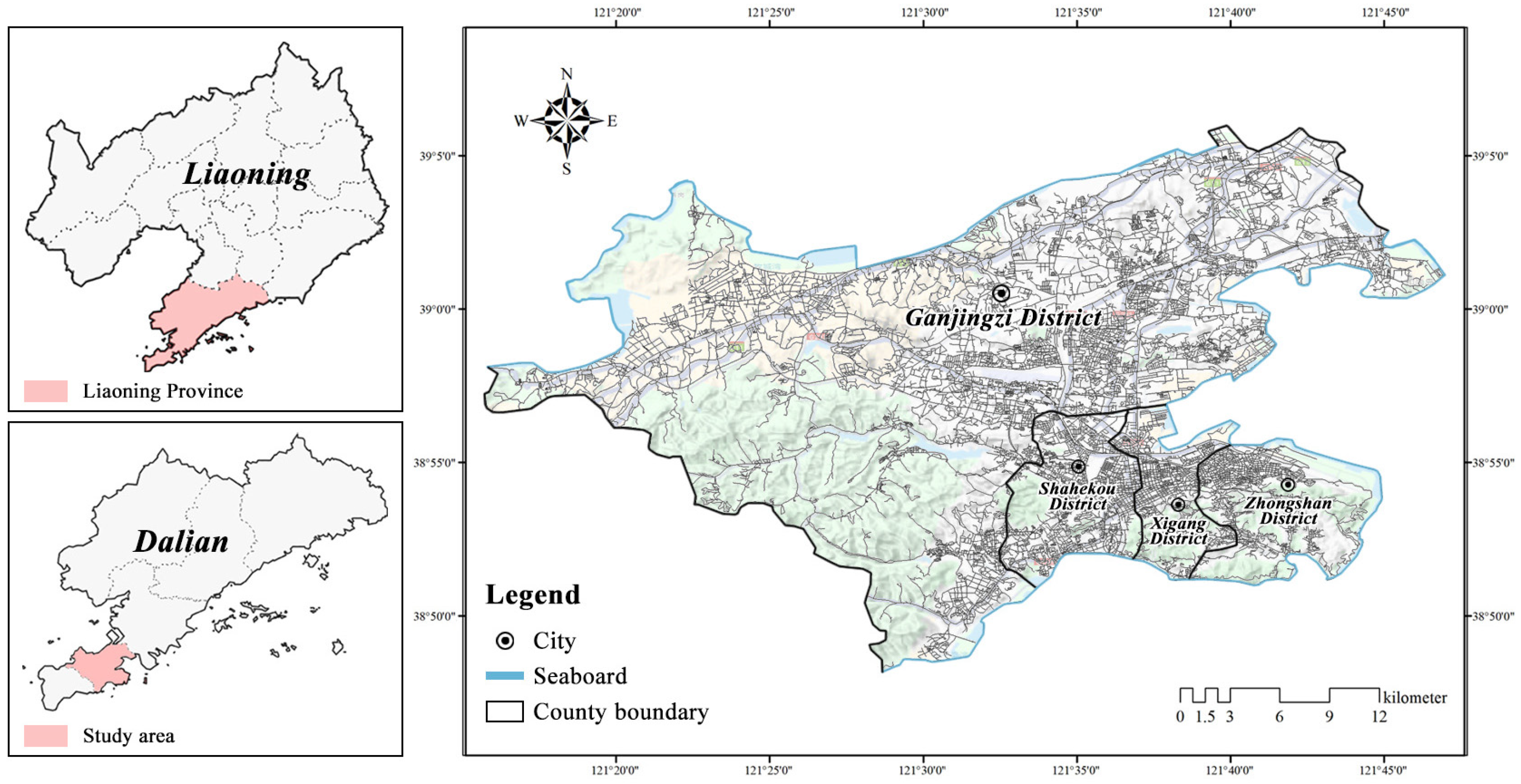
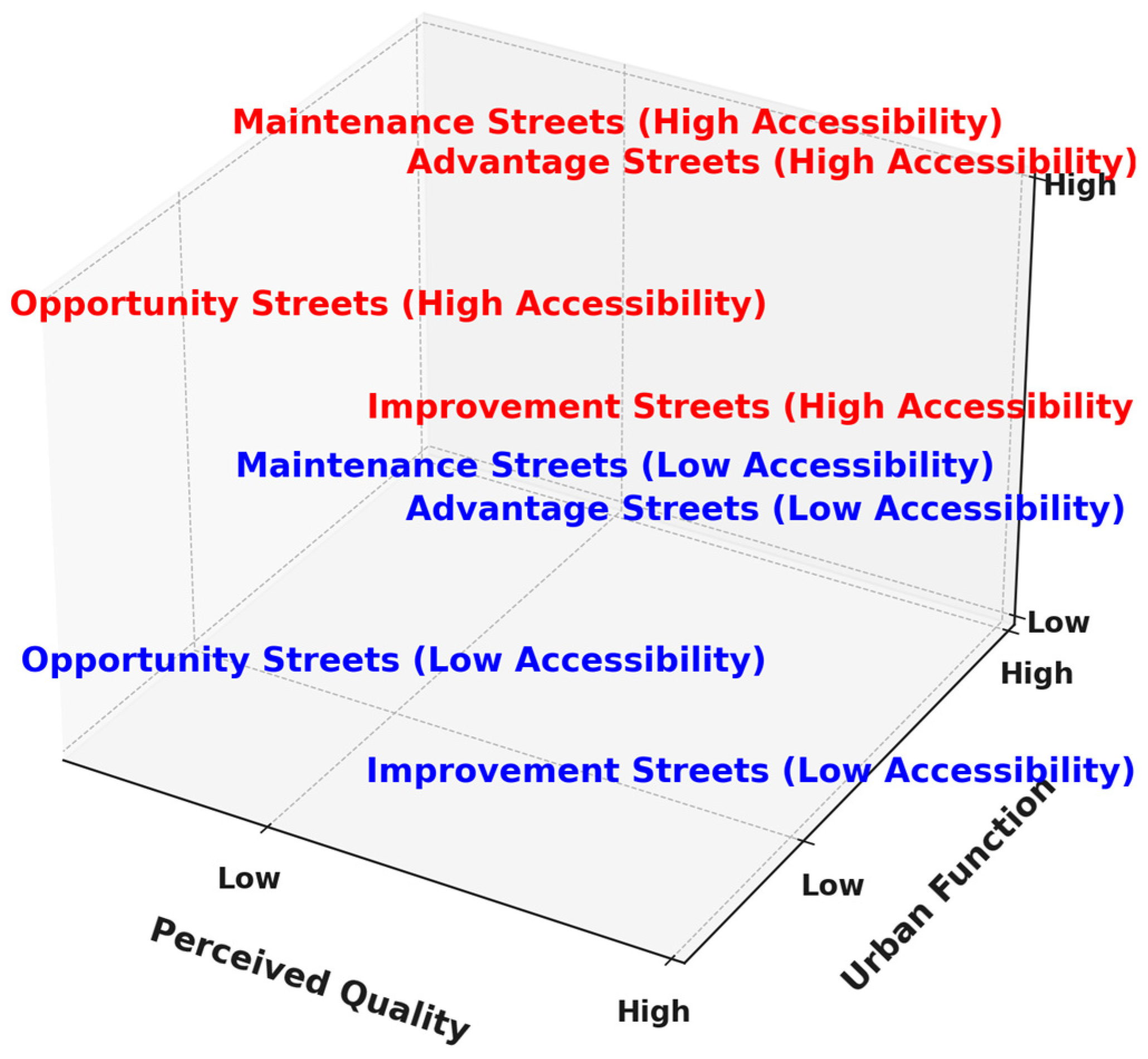
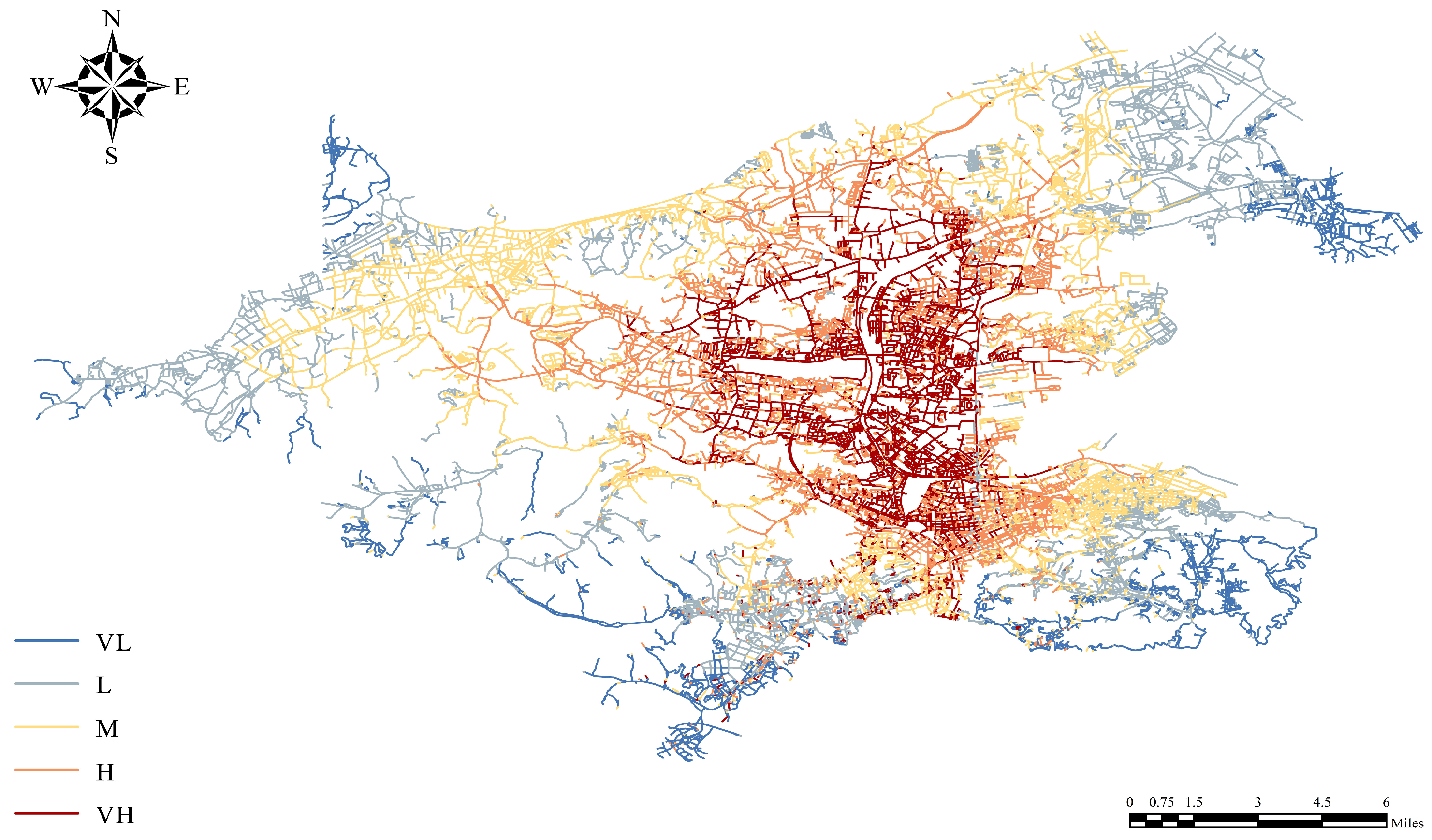
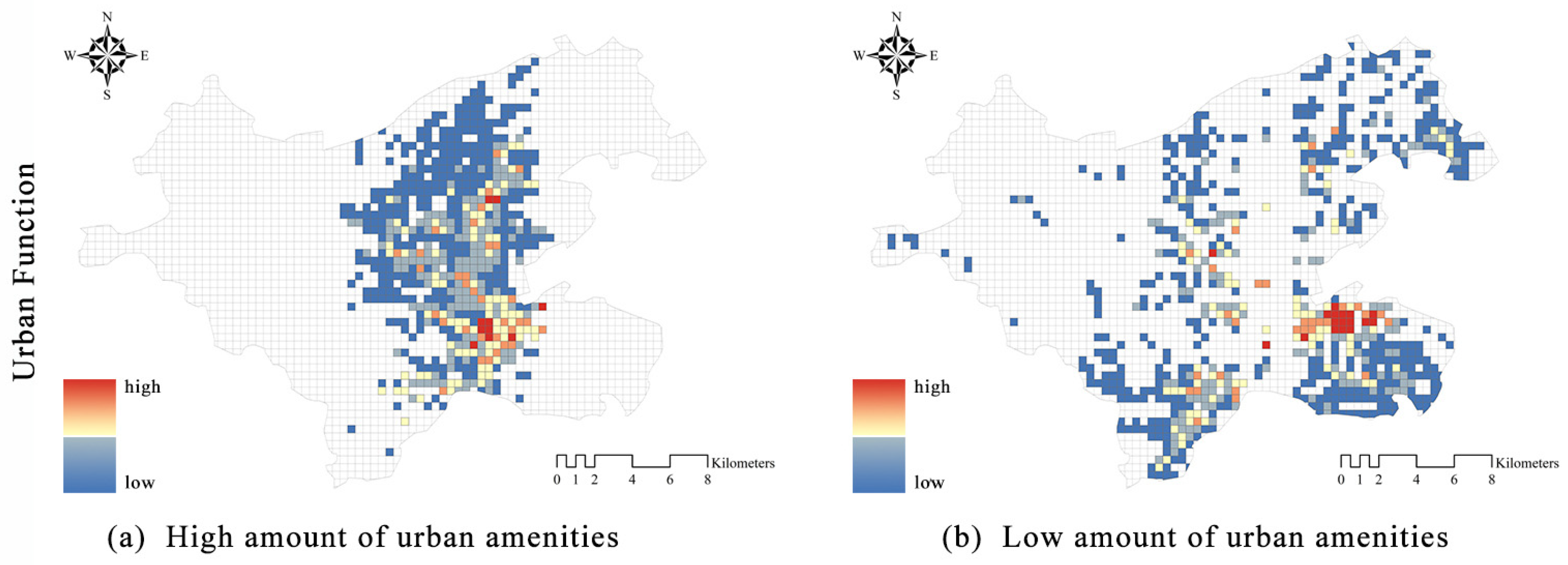
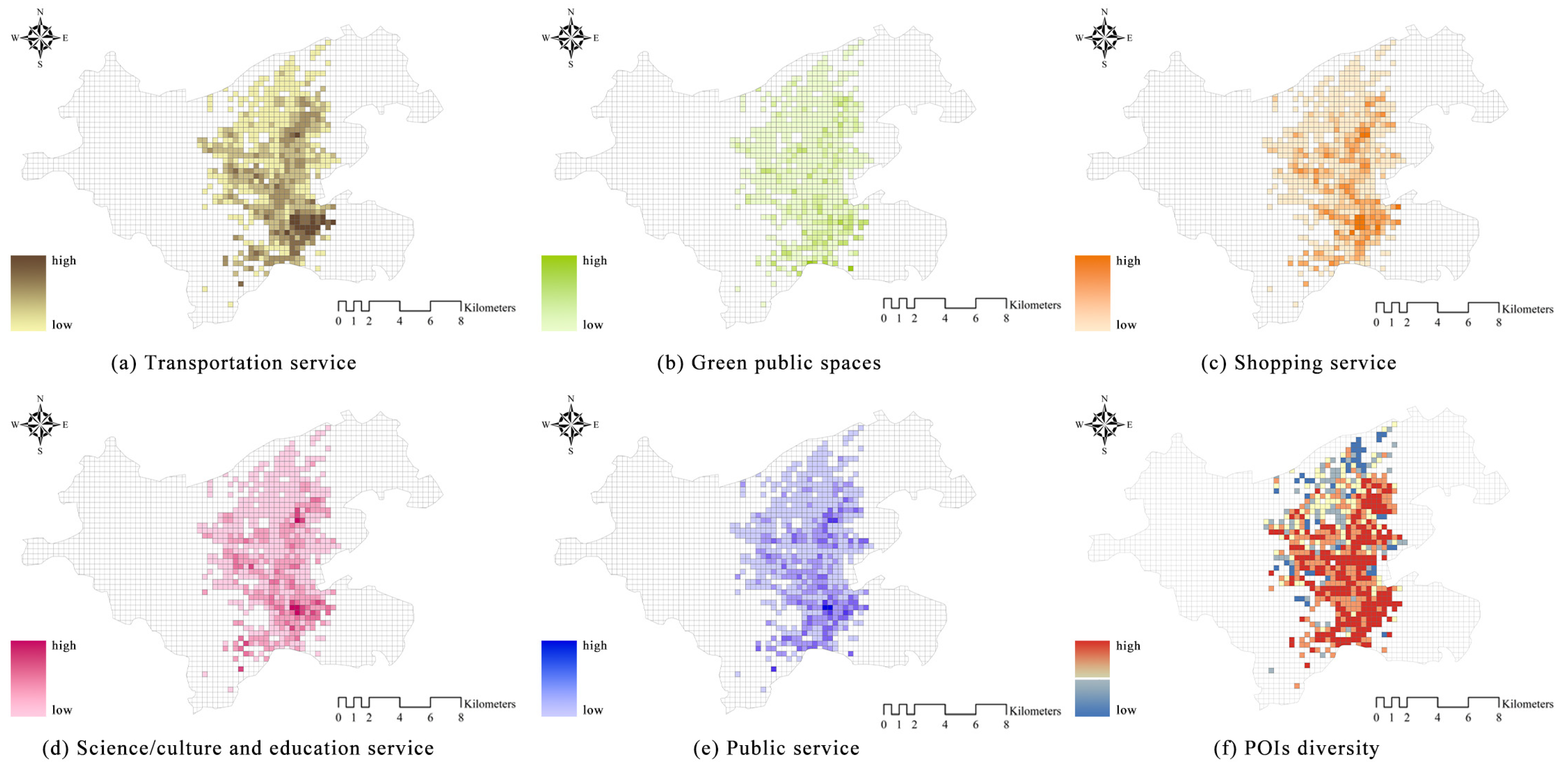
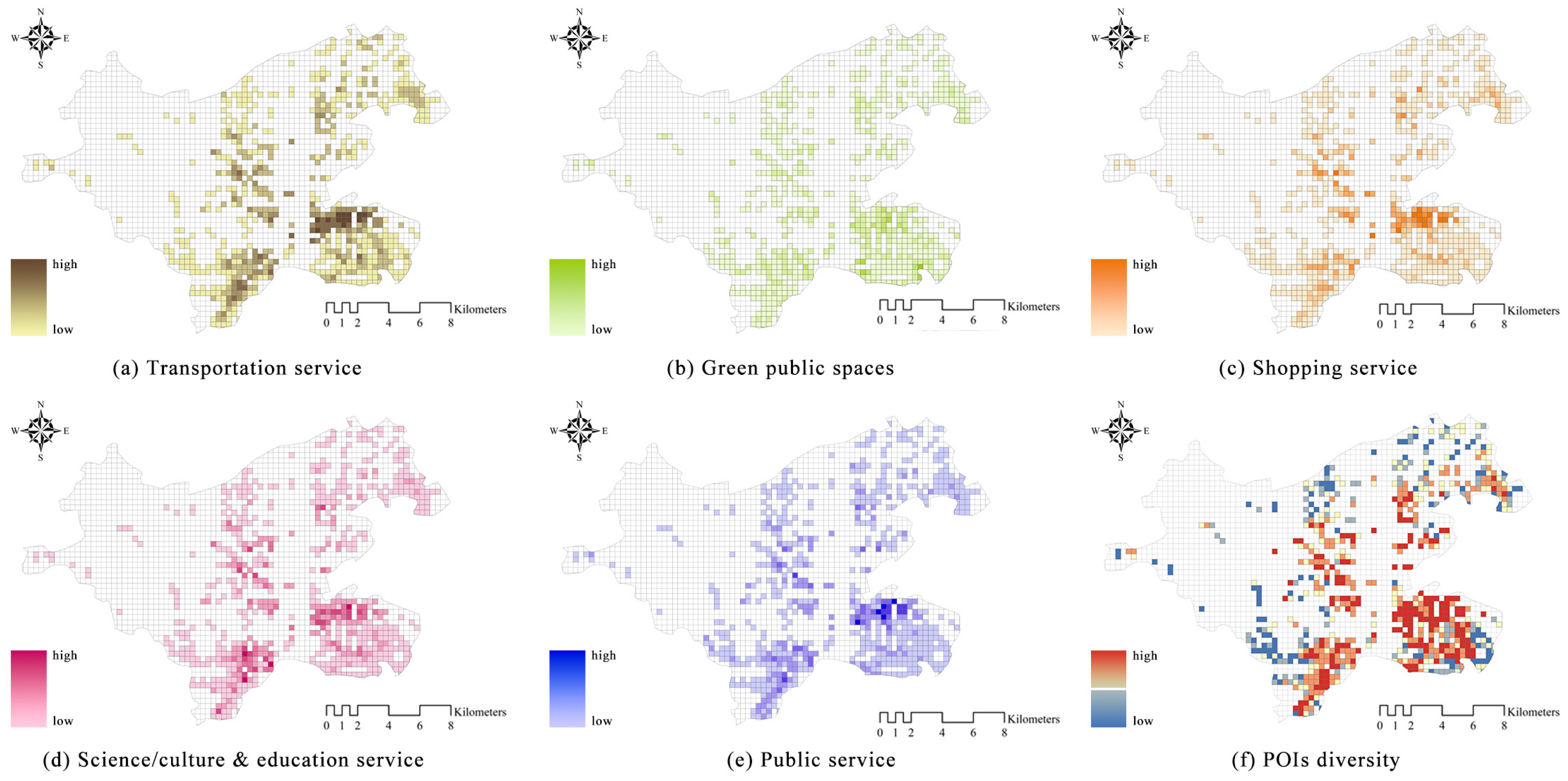



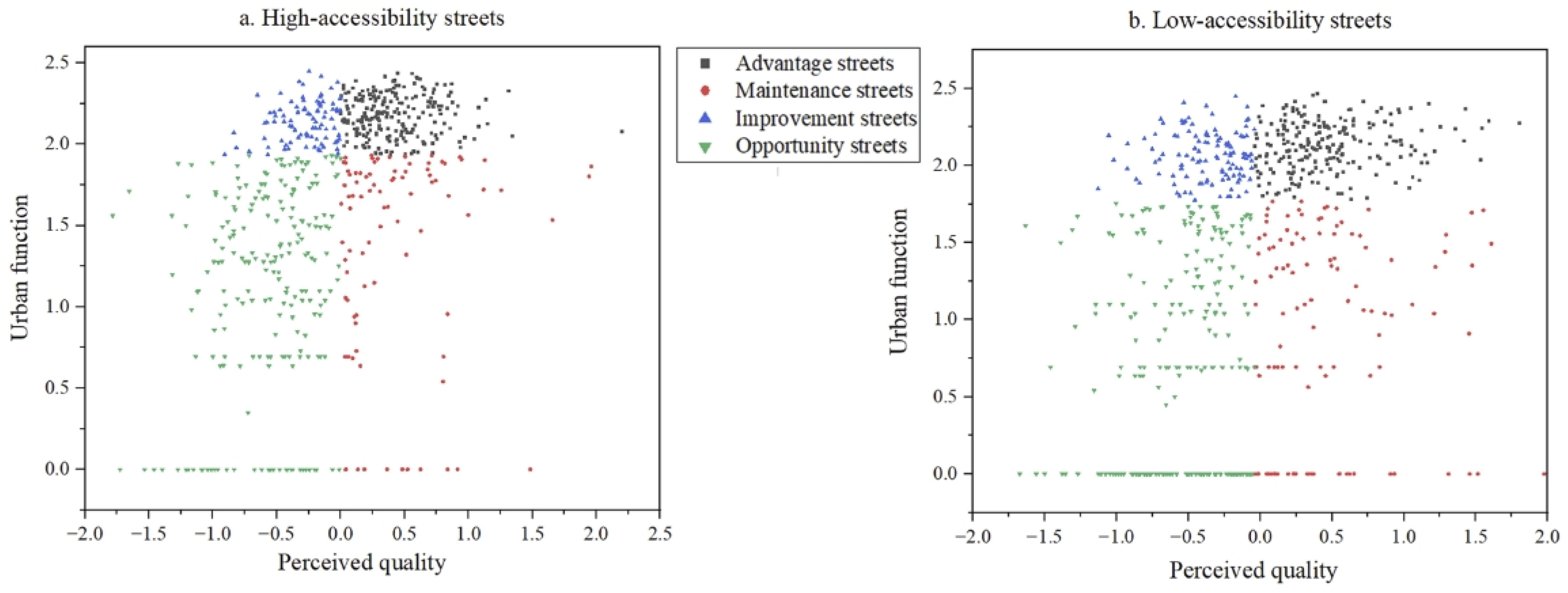
| Features | Formula | Expression | Features |
|---|---|---|---|
| Urban function | POI diversity | is the proportion in terms of the number of class I facilities in regard to the total number of facilities. | |
| Shopping service density | Num (N) is the number of shopping services in the buffer area in terms of the N th sample point. | ||
| Science/culture and education service density | Num (N) is the number of science/culture and education services in the buffer area in terms of the N th sample point. | ||
| Public facility density | Num (N) is the number of public facilities in the buffer area in terms of the N th sample point. | ||
| Transportation service density | Num (N) is the number of transportation services in the buffer area in terms of the N th sample point. | ||
| Green public space density | Num (N) is the number of green public spaces in the buffer area in terms of the N th sample point. | ||
| Objective perception | Imageability | denotes the proportion of building pixels, denotes the proportion of signboard pixels. | |
| Openness | denotes the proportion of sky pixels. | ||
| Enclosure | is the percentage of building pixels; is the percentage of tree pixels; is the percentage of wall pixels; is the percentage of pavement pixels; is the percentage of fence pixels; is the percentage of road pixels. | ||
| Greenness | denotes the proportion of tree pixels, denotes the proportion of grass pixels. | ||
| Walkability | is the percentage of sidewalk pixels; is the percentage of fence pixels; is the percentage of road pixels. | ||
| Paved sidewalk | is the percentage of sidewalk pixels; is the percentage of road pixels. | ||
| Psychological perception | Beautiful | Human perception of the locals as beautiful. | |
| Lively | Human perception of the locals as lively. | ||
| Boring | Human perception of the locals as boring. | ||
| Depressing | Human perception of the locals as depressing. | ||
| Safe | Human perception of the local area as safe. | ||
| Wealthy | Human perception of locals as wealthy. |
| First Indicators | Secondary Indicators | Weight |
|---|---|---|
| Objective perception | Imageability | 0.136 |
| Openness | 0.209 | |
| Enclosure | 0.100 | |
| Greenness | 0.200 | |
| Walkability | 0.200 | |
| Paved sidewalk | 0.155 | |
| Psychological perception | Beautiful | 0.242 |
| Lively | 0.211 | |
| Boring | 0.074 | |
| Depressing | 0.063 | |
| Safe | 0.232 | |
| Wealthy | 0.179 |
| High-Accessibility Streets | Low-Accessibility Streets | ||
|---|---|---|---|
| Green public space | Density | 0.364 | 0.482 |
| The proportion of high-value amenities | 0.98% | 1.02% | |
| Shopping service | Density | 47.4 | 32.209 |
| The proportion of high-value amenities | 4.89% | 3.48% | |
| Transportation service | Density | 12.018 | 9.269 |
| The proportion of high-value amenities | 6.20% | 4.35% | |
| Public facility | Density | 2.439 | 1.903 |
| The proportion of high-value amenities | 1.79% | 1.45% | |
| Science/culture and education service | Density | 5.866 | 4.331 |
| The proportion of high-value amenities | 5.71% | 3.19% | |
| POI diversity | Density | 1.679 | 1.449 |
| The proportion of high-value amenities | 66.39% | 50.65% |
| Indicators | High-Accessibility Streets | Low-Accessibility Streets | ||
|---|---|---|---|---|
| Mean Value | Standard Deviation | Mean Value | Standard Deviation | |
| Perceived quality | 18.63 | 1.329 | 18.542 | 1.437 |
| Objective perception | 0.363 | 0.275 | 0.45 | 0.399 |
| Openness | 0.569 | 0.076 | 0.55 | 0.084 |
| Greenness | 0.06 | 0.048 | 0.078 | 0.070 |
| Paved sidewalk | 0.085 | 0.073 | 0.097 | 0.092 |
| Walkability | 0.237 | 0.549 | 0.318 | 2.258 |
| Imageability | 0.14 | 0.097 | 0.132 | 0.099 |
| Enclosure | 1.527 | 2.431 | 1.748 | 2.869 |
| Psychological perception | 36.898 | 2.649 | 36.635 | 2.833 |
| Beautiful | 34.375 | 5.815 | 34.676 | 6.913 |
| Boring | 59.159 | 3.624 | 60.353 | 4.663 |
| Depressing | 50.825 | 3.436 | 51.226 | 3.880 |
| Lively | 32.426 | 5.186 | 31.06 | 6.625 |
| Safe | 33.764 | 2.786 | 33.457 | 3.614 |
| Wealthy | 35.545 | 3.921 | 35.042 | 4.759 |
| Diagnosed Streets | High-Accessibility Streets | Low-Accessibility Streets | ||
|---|---|---|---|---|
| Number | Proportions | Number | Proportions | |
| Advantage Streets | 216 | 35.23% | 230 | 33.42% |
| Maintenance Streets | 92 | 15.01% | 115 | 16.72% |
| Improvement Streets | 91 | 14.85% | 115 | 16.72% |
| Opportunity Streets | 214 | 34.91% | 228 | 33.14% |
| POIs Diversity | Public Facility | Shopping Service | Transportation Service | Sports Service | Science/Culture and Education Service | |||
| Advantage Streets | 2.18 | 20.70 | 75.76 | 0.51 | 4.39 | 11.12 | ||
| Maintenance Streets | 2.14 | 14.76 | 42.97 | 0.6 | 2.93 | 6.91 | ||
| Improvement Streets | 1.35 | 7.98 | 64.32 | 0.36 | 2.13 | 4.21 | ||
| Opportunity Streets | 1.12 | 3.83 | 13.39 | 0.11 | 0.39 | 0.84 | ||
| Perceived Quality | Openness | Greenness | Paved Sidewalk | Walkability | Imageability | Enclosure | Objective Perception | |
| Advantage Streets | 0.43 | −0.77 | −0.04 | 0.66 | 0.04 | 0.68 | 0.04 | 0.07 |
| Maintenance Streets | −0.28 | 0.09 | 0.09 | −0.02 | −0.1 | −0.14 | −0.15 | −0.17 |
| Improvement Streets | 0.60 | −0.20 | 0.06 | 0.03 | 0.37 | 0.15 | 0.47 | 0.66 |
| Opportunity Streets | −0.58 | 0.82 | −0.02 | −0.67 | −0.16 | −0.69 | −0.18 | −0.28 |
| Beautiful | Boring | Depressing | Lively | Safe | Wealthy | Psychological Perception | ||
| Advantage Streets | 0.27 | 0.33 | 0.37 | 0.72 | 0.54 | 0.64 | 0.80 | |
| Maintenance Streets | −0.22 | 0.00 | −0.20 | −0.33 | −0.24 | −0.21 | −0.38 | |
| Improvement Streets | 0.47 | 0.02 | 0.02 | 0.43 | 0.15 | 0.27 | 0.54 | |
| Opportunity Streets | −0.38 | −0.34 | −0.30 | −0.77 | −0.51 | −0.67 | −0.88 |
| POIs Diversity | Public Facility | Shopping Service | Transportation Service | Sports Service | Science/Culture and Education Service | |||
| Advantage Streets | 2.13 | 0.88 | 64.79 | 17.83 | 3.92 | 8.81 | ||
| Maintenance Streets | 2.06 | 0.44 | 41.80 | 13.09 | 2.72 | 6.31 | ||
| Improvement Streets | 0.91 | 0.5 | 8.33 | 3.04 | 0.28 | 1.39 | ||
| Opportunity Streets | 0.73 | 0.10 | 6.66 | 1.88 | 0.28 | 0.31 | ||
| Perceived Quality | Openness | Greenness | Paved Sidewalk | Walkability | Imageability | Enclosure | Objective Perception | |
| Advantage Streets | 0.47 | −0.47 | −0.08 | 0.33 | −0.01 | 0.56 | 0.03 | 0.17 |
| Maintenance Streets | −0.38 | 0.06 | −0.29 | 0.00 | −0.04 | 0.10 | −0.14 | −0.18 |
| Improvement Streets | 0.56 | −0.2 | 0.49 | 0.17 | 0.19 | −0.18 | 0.16 | 0.48 |
| Opportunity Streets | −0.57 | 0.54 | −0.02 | −0.42 | −0.07 | −0.52 | −0.05 | −0.32 |
| Beautiful | Boring | Depressing | Lively | Safe | Wealthy | Psychological Perception | ||
| Advantage Streets | 0.08 | 0.14 | 0.37 | 0.74 | 0.46 | 0.60 | 0.77 | |
| Maintenance Streets | −0.36 | −0.11 | −0.19 | −0.27 | −0.24 | −0.41 | −0.57 | |
| Improvement Streets | 0.68 | 0.14 | −0.06 | 0.2 | 0.23 | 0.22 | 0.65 | |
| Opportunity Streets | −0.24 | −0.16 | −0.25 | −0.70 | −0.46 | −0.50 | −0.81 |
Disclaimer/Publisher’s Note: The statements, opinions and data contained in all publications are solely those of the individual author(s) and contributor(s) and not of MDPI and/or the editor(s). MDPI and/or the editor(s) disclaim responsibility for any injury to people or property resulting from any ideas, methods, instructions or products referred to in the content. |
© 2025 by the authors. Licensee MDPI, Basel, Switzerland. This article is an open access article distributed under the terms and conditions of the Creative Commons Attribution (CC BY) license (https://creativecommons.org/licenses/by/4.0/).
Share and Cite
Meng, Y.; Lyu, M.; Sun, D.; Shi, J.; Fukuda, H. Evaluating and Diagnosing Urban Function and Perceived Quality Based on Multi-Source Data and Deep Learning Using Dalian as an Example. Buildings 2025, 15, 998. https://doi.org/10.3390/buildings15070998
Meng Y, Lyu M, Sun D, Shi J, Fukuda H. Evaluating and Diagnosing Urban Function and Perceived Quality Based on Multi-Source Data and Deep Learning Using Dalian as an Example. Buildings. 2025; 15(7):998. https://doi.org/10.3390/buildings15070998
Chicago/Turabian StyleMeng, Yumeng, Mei Lyu, Dong Sun, Jiaxuan Shi, and Hiroatsu Fukuda. 2025. "Evaluating and Diagnosing Urban Function and Perceived Quality Based on Multi-Source Data and Deep Learning Using Dalian as an Example" Buildings 15, no. 7: 998. https://doi.org/10.3390/buildings15070998
APA StyleMeng, Y., Lyu, M., Sun, D., Shi, J., & Fukuda, H. (2025). Evaluating and Diagnosing Urban Function and Perceived Quality Based on Multi-Source Data and Deep Learning Using Dalian as an Example. Buildings, 15(7), 998. https://doi.org/10.3390/buildings15070998






